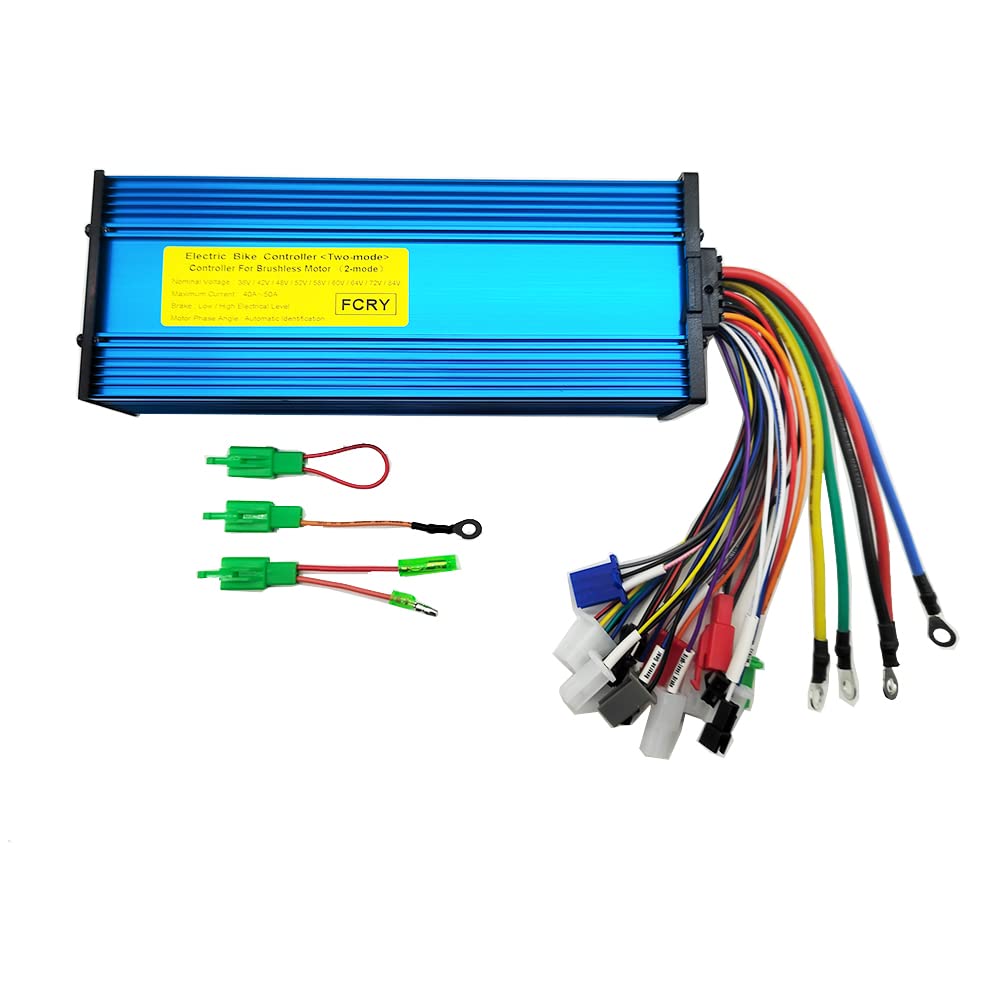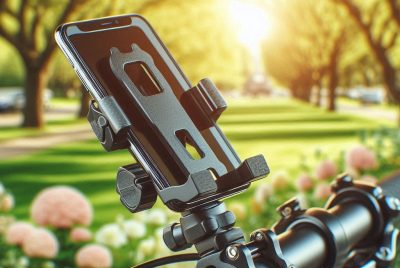Electric Bike Controller: Enhancing Ride Performance
*We may earn a commission for purchases made using our links. Please see our disclosure to learn more.
Electric Bike Controller: Enhancing Your Ride’s Performance
Electric bikes, or e-bikes, have surged in popularity in recent years, offering a sustainable and efficient mode of personal transportation. These two-wheeled vehicles merge the physical advantages of traditional bicycling with the power assistance of an electric motor, attracting a diverse group of riders seeking to reduce carbon footprints, tackle challenging terrain, or simply enjoy a less strenuous ride. Central to the e-bike’s functionality is the electric bike controller, a component that acts as the brain of the bike. It modulates power supplied to the motor based on input from the rider, through a throttle or pedal-assist sensors, ensuring a smooth and responsive riding experience. The controller’s ability to manage battery power translates directly to the bike’s performance and range, making it a critical piece of the e-bike puzzle.
When considering the purchase of an electric bike controller, it’s crucial to pay attention to compatibility with your e-bike’s motor and battery voltage, the level of pedal-assist customization, and the waterproof rating of the controller. The selection process can become intricate as controllers come with a variety of features designed to cater to different riding styles and preferences.
By understanding the integral role of the e-bike controller, I’ve been meticulous in examining their features and performance. This examination ensures that enthusiasts and daily commuters alike can find a controller that not only aligns with their e-bike specifications but also enhances their riding experience.
Top Electric Bike Controller Selections
After meticulous research and testing, I’ve compiled a selection of the top electric bike controllers in the market. These devices stand out for their reliability, performance, and user-friendly features, ensuring cyclists can enhance their riding experience with precision and ease. Whether you’re upgrading your current e-bike or building a new one from scratch, this list is specifically crafted to guide you in making an informed decision for your electric bike setup.
ChongXiao Brushless Controller
I’d recommend this controller for anyone looking to upgrade their electric bike or scooter for smoother and more efficient performance.
Pros
- Versatile voltage compatibility, fits various setups
- Smooth operation and user-friendly interface
- Durable and reliable with a built-in safety mechanism
Cons
- Might be overpowered for systems below 1500W
- Requires precise installation to function correctly
- Limited documentation can challenge less experienced users
Just installed this ChongXiao Brushless controller on my e-bike, and the transformation in performance was immediately noticeable. The bike now accelerates more smoothly, and there’s a notable difference in stability, especially at higher speed settings. The controller’s intelligent recognition system efficiently managed 60° and 120° phases without any hitches for a universal fit that was plug-and-play once properly connected.
Navigating through traffic with this controller proved its worth. The throttle was responsive and offered precise control over speed, which helped in maintaining a steady pace. I found the high-level brake integration a valuable safety feature, ensuring my rides were not only fast but safe too. Users will appreciate the different modes that easily adapt to various riding conditions.
Despite the splendid performance, installation required a bit of focus. I had to ensure the motor phase lines were correctly paired, and the self-learning lines configured rightly to prevent the wheel from reversing. This controller is an excellent choice for those confident in managing their e-bike’s technical aspects but might pose a challenge for beginners. Its potential remains untapped if not installed correctly, which could dissuade those unfamiliar with e-bike mechanics.
In conclusion, the ChongXiao Brushless Controller excels in upgrading your e-bike’s or scooter’s performance, adding efficiency, and providing a superior riding experience. As long as you’re comfortable with detailed setup procedures, this product is an investment that pays off by significantly enhancing your ride’s quality and responsiveness.
Alomejor E-Bike Controller Kit
If you’re in the market for a versatile e-bike controller with a clear display and straightforward installation, this could be a solid pick.
Pros
- The waterproof construction and durable materials offer peace of mind in various weather conditions.
- Installation is a breeze thanks to the color-coded cables, and the intuitive display keeps all pertinent info at a glance.
- Features like the 3-level backlight and programmable settings enhance overall user experience.
Cons
- The 3.6-star rating suggests some users faced challenges, possibly related to the product’s longevity or support.
- Documentation and customer support may be lacking, which could be frustrating for troubleshooting.
- Some riders could find the controller’s performance to not meet their power needs based on reviews mentioning weakness.
As someone always tinkering with my gear, I found the Alomejor E-Bike Controller Kit refreshingly simple to set up on my rig. The color-coded wires and clear instructions made the installation nearly foolproof. The unit’s robust build and the fact that it’s waterproof mean that I’m not fretting about getting caught in a downpour.
Once installed, the LCD display provided me with easy-to-read feedback. I could quickly ascertain my speed, select different power modes, and check the battery level, all of which took my riding efficiency to the next level. The backlight settings were a bonus for those dusk adventures or early morning commutes.
While the overall functionality met my expectations, I did notice a few reviews highlighting the lack of detailed support from the manufacturer. This could be a dealbreaker for less experienced users who need that extra guidance. Moreover, despite the neat feature set, a handful of reviews pointed out that the controller didn’t quite deliver the power output they’d hoped for, and some glitches were mentioned.
In summary, the Alomejor Controller Kit is a functional upgrade for your electric bike—but weigh the pros and cons carefully, as your experience may vary based on technical savvy and power needs.
Fafeims E-Bike Controller
If you’re seeking to refresh your e-bike’s performance, this Fafeims controller brings a blend of reliability with trace amounts of trial and error.
Pros
- The build is sturdy and water-resistant, boosting durability.
- Backlit LCD is highly readable, offering key ride metrics.
- Color-coded cables simplify the initial installation process.
Cons
- Speed display may not reflect actual speed, causing some guesswork.
- Not universally compatible, particularly with bike pedal assist systems.
- No instructions for hub control wire connections, which might be confusing for some users.
I recently had the chance to upgrade my e-bike with Fafeims’s electric bike controller. The first thing that struck me was the robust construction; the materials feel capable of withstanding some serious usage, and the water resistance gives peace of mind on rainy day commutes.
During the evening rides, the LCD backlit display was a standout feature. It made monitoring my speed, battery level, and other settings a breeze. It’s a well-thought-out feature that allows customization according to light conditions, contributing to a safer ride.
However, when the road got bumpy, the controller had its shortcomings. For enthusiasts of peddle assist, it falls short. Matching the controller to my e-bike required some fiddling, and the incorrect speed readings were slightly disconcerting at high speeds.
Installation brought its own challenges. While I appreciate the color-coded wires, the lack of guidance on connecting hub control wires meant some trial and error was inevitable. For someone less experienced, this could be a daunting hurdle.
Lastly, while this controller functions adequately for the most part, it might be best suited for scooters, as suggested by some user feedback. My experience suggests double-checking compatibility could save time and avoid disappointments.
Yuandai Brushless Motor Controller
I’d recommend this controller for someone looking for an affordable upgrade to their e-bike or scooter that balances functionality with simplicity.
Pros
- Responsive performance that enhances riding experience
- Sturdy aluminum alloy construction ensures durability
- Simple installation with clearly labeled interfaces
Cons
- May struggle to maintain programming, creating inconsistencies
- Potentially overwhelming power output for light bikes
- Some units might arrive with quality control issues
Upon installing the Yuandai controller on my e-scooter, the first thing I noticed was the construction quality. The aluminum casing felt robust and gave me confidence in its ability to handle the bumps and vibrations of everyday riding. A particularly smooth ride followed, credit to the sensitive control this unit provides. I felt a distinct difference in how my scooter handled acceleration and braking – it was like giving it a new lease on life.
However, while the power was impressive, there was an initial concern. On a lightweight folding bike, the torque seemed overzealous; from a standstill, the wheelie temptation was evident. Riders of such bikes should exercise caution and consider additional modifications such as torque arms to manage this potent energy adequately.
Despite some reports of programming retention problems, I had no such issues. After a few simple steps outlined in the instructions, my setup was complete and retained the settings without hiccups. That said, I heard uneven anecdotes among fellow riders, with some experiencing frustrating inconsistencies.
The Yuandai Brushless Motor Controller is an effective choice for the DIY enthusiast looking to tweak their e-bike’s performance. My experience suggests you’ll enjoy not only a noticeable boost in response but will appreciate the straightforward installation as well. While it may not be without its quirks, the pros certainly tipped the scales in its favor for my scooter upgrade project.
VGEBY E-Bike Controller Kit
Having recently equipped my e-bike with this VGEBY kit, I find it dependable for a seamless riding experience.
Pros
- Solid build quality ensures durability and reliability
- Provides precise control over braking and acceleration
- Backlit LCD display enhances visibility in various lighting conditions
Cons
- Installation guidance is insufficient and can be confusing
- Occasional communication errors between the controller and the display
- Limited compatibility with only some e-bike models
After installing the VGEBY E-Bike Controller Kit on my electric bike, I noticed the immediate difference in how it felt to ride. The sturdy metal construction of the controller housing gives me confidence that it will last for many commutes and adventures, while also keeping the important circuitry well-protected due to its efficient heat dissipation. In the past, I’ve had issues with controllers overheating, but this design seems to have addressed that concern well.
On the road, the control over speed is smooth and responsive, making it much easier to manage my bike’s pace, especially in traffic. The sensitivity of the braking and directional changes impresses me; it has really taken my biking experience up a notch in terms of safety and handling.
The clear LCD display is particularly handy during evening rides, thanks to its backlight. Visibility of my speed, battery level, and other key performance data has never been clearer, which allows me to focus more on the road than squinting at my handlebars trying to decipher numbers.
However, I did face some hurdles with setting up the VGEBY kit. The instructions provided weren’t as clear as I would have liked, and I ended up looking online for additional guidance. It’s something to note, especially for those who aren’t as tech-savvy or prefer straightforward installation.
I’ve also observed occasional communication errors shown on the display, which can be frustrating mid-ride. Such technical glitches aren’t frequent but worth mentioning for potential buyers to be aware of. It’s something I’ll be keeping an eye on to ensure it doesn’t develop into a larger issue.
Lastly, this controller kit isn’t universal, so check compatibility with your e-bike model before purchasing. Compatibility issues can be a deal-breaker for many potential users. I was lucky enough to own a model that aligns well with this controller’s specifications.
Buying Guide
When considering the purchase of an electric bike controller, I always look at certain features to ensure I choose the best product for my needs. Below, I’ve outlined key aspects to evaluate during your selection process.
Compatibility
Firstly, I check the controller’s compatibility with my e-bike’s motor and voltage. It’s essential the controller can handle the motor’s wattage and matches the battery voltage.
- Voltage & Wattage: The controller’s specifications must align with my e-bike’s battery and motor.
Types of Controllers
Different types of controllers offer varying levels of control and responsiveness. I always consider whether I prefer a sensorless or sensored controller.
- Sensored Controllers: These provide smooth operation and are ideal for those who prioritize a refined ride.
- Sensorless Controllers: Often more rugged and cost-efficient, suitable for those who may not require sophisticated start-up torque control.
Performance Features
I look into the performance features such as current and power limits, as these can directly affect my riding experience.
- Current Limits: To protect the motor and battery, I check the current limits to ensure they meet safety standards.
- Power Settings: I determine if the controller allows for different power settings, giving me the flexibility to customize my ride.
Connectivity
The ability to connect my controller to peripheral devices is also a point of consideration.
- Display Interfaces: A controller with a display interface for real-time data is useful.
- Connectivity Options: Options like Bluetooth or USB ports for diagnostics and updates are convenient features.
Durability and Protection
The build quality and protective features such as waterproofing are crucial for longevity and safe operation.
- Construction: A sturdy build is necessary for withstanding regular use.
- Waterproof Rating: To ensure my controller is resilient in various weather conditions, I check its waterproof rating.
User-Friendly Interface
I prefer a controller that offers an intuitive interface with easily adjustable settings.
- Adjustability: The easier it is to adjust settings, the better control I have over my ride.
By focusing on these features without exaggeration or brand preference, I can make a confident and informed selection when choosing an electric bike controller.
FAQs About Your Electric Bike Controller
In this section, I’ll address some common inquiries about electric bike controllers, touching on selection, performance upgrades, installation considerations, and maintenance.
1. How do I choose the correctly rated controller for my electric bike?
Choosing the right controller requires matching the voltage and current ratings with your e-bike’s motor and battery specifications. I ensure that the dimensions of the controller are compatible with my bike’s frame for easy mounting.
2. What are the signs of a failing ebike controller?
Symptoms of a failing controller include erratic motor behavior, reduced performance, or complete failure to power the bike. If my bike shows these signs, I check the controller connections and look for burn marks or damage.
3. Can I upgrade my electric bike controller for better performance?
Yes, upgrading my controller can improve performance, but I need to make sure the new controller is compatible with my electric bike’s motor, battery voltage, and current limits to prevent damage.
4. What should I consider when installing a new controller on my electric bike?
When installing a new controller, I consider the controller’s physical fit into my bike, its compatibility with my bike’s electrical system, and proper heat dissipation. I also ensure that all connections are secure and waterproof if necessary.
5. What maintenance is required for electric bike controllers?
Maintenance for electric bike controllers typically involves keeping the unit clean and dry, checking for secure connections, and inspecting for any signs of wear or damage. I regularly inspect my bike’s controller as part of routine maintenance to ensure reliability.









